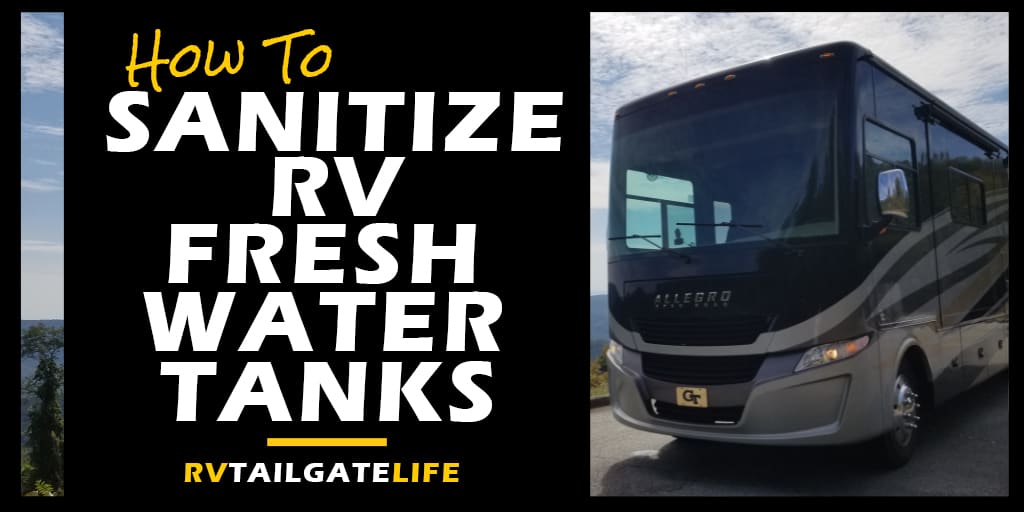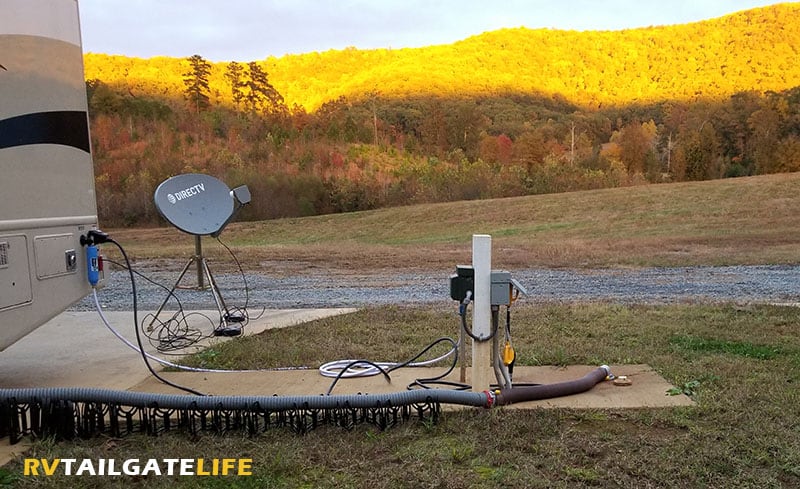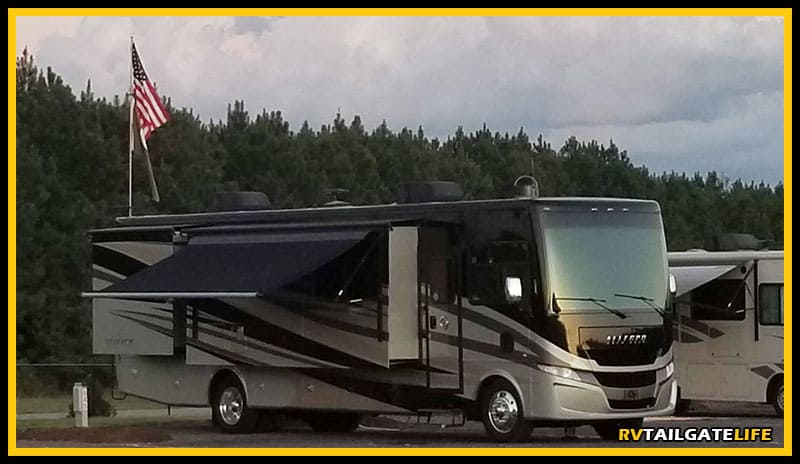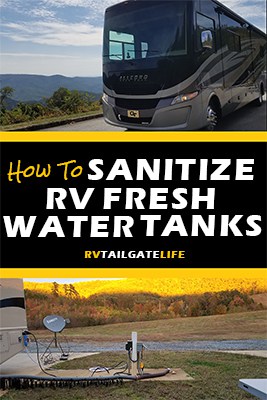How to Sanitize the RV Fresh Water System
Are you worried about drinking water from your RV fresh water system?
Maybe the water coming out of your fresh water system is smelling?
Whatever the case may be, it is time to sanitize your RV fresh water system.

Why You Should Sanitize Your RV Fresh Water System
No one wants to be concerned about any bacteria or mold that is growing in the dark and damp spaces below the RV and in the plumbing. But we also want to make RV life as easy as possible.
I know that I have spent way too much money on my motorhome to not enjoy it to its fullest. Which yes, includes taking showers in it, brushing my teeth, and just living like it is home.
I don’t want to worry about bringing in bottled fresh water when I have this large fresh water tank on board.
See Also: Do You Leave Black and Gray Tanks Open or Closed?
What You Need to Sanitize Your RV Fresh Water System

Sanitizing your fresh water tank won’t take any special tools and you already have at least half of them on hand (or maybe all of them).
Here’s what you will need:
- Bleach – household bleach, but not the colored or scented version.
- Funnel – I prefer one with a flexible spout. Do not use the one you use with your generator or engine oil!
- Fresh Water Hose – Use the one you already use to fill up your fresh water tank
- Water bucket
- Measuring Cup
Easy Steps to Sanitizing the RV Fresh Water Plumbing
Sanitizing the RV fresh water system is actually really easy. Just follow these seven steps to a fresh and safe water system.
- Prepare a bleach solution of 1/4 cup per 15 gallons of fresh water.
- Pour this solution into the RV fresh water tank.
- Run each faucet until you can smell bleach.
- Let the whole system sit and soak with the bleach solution for at least four hours.
- Drain the fresh water tank.
- Refill the tank with fresh water tank with fresh, unbleached water.
- Flush each pipe by opening up the drains and running fresh water until you can no longer smell bleach.
You now have a freshly sanitized RV fresh water tank!

Frequently Asked Questions about Sanitizing RV Fresh Water Tanks
Long-term use of bleach in your RV water system may hurt the RV plumbing, in particular the seals in your black and gray tanks. However, sporadic use will not damage the seals. The benefits far outweigh the risks of the short-term exposure!
Honestly, no. The 1/4 cup per 15 gallons is a guideline, not a hard and fast rule. And really skunky tanks may even take more to get them clean or even multiple sanitizing rounds. Just make sure that you do dilute it and aren’t filling up your entire tank with pure bleach. After all, who wants to spend that kind of money on sanitizing your tanks when a lot less will do the job?
It’s actually not necessary to empty the RV fresh water before you begin this process. The important thing is that you get the proper amount of bleach in your fresh water system.
There are two easy ways to get the bleach solution into your tanks.
The easiest way is to pour it into the gravity fill using a funnel.
If you don’t have a gravity fill on your fresh water tank, the next easiest thing to do is to pour the bleach into the water hose and fill the tanks through the city water connection. Added bonus – disinfecting your hose too!
It’s a great idea to sanitize the hot water system and pipes too! However, since we should not boil or overheat bleach (to avoid chlorine gas), make sure to start with cool water and leave the water heater off throughout the entire process!
It’s a great time to check the anode rod in your RV water heater!
It is generally advisable that you only use clean, fresh water for this process. Any external water filters, like at the water hookup will be fine. However, any filters inside your RV, like at the water tank fill or in your RV fridge, you’ll want to remove and bypass.
If you are putting the bleach in your hose to get it into your tanks, make sure you put the bleach inline AFTER the filter. This way you don’t wear out your filter earlier than necessary or damage it in the sanitizing process.
It is highly advisable that you empty the RV black tank before putting any bleach in the tank. When bleach combines with ammonia, which is found in human urine, you get chlorine gas. Chlorine gas is not pleasant and can pose serious health risks. Fortunately, you do not need to send the bleach solution through the black tank. Just the fresh water system and the gray tank will be sufficient!
After you drain the water out, you might find that it is hard to get all the traces out of the plumbing. The best thing to do is to keep flushing it with cool, fresh water. However, if you leave trace amounts of bleach in the water, you won’t be doing any damage to the RV. And it is safe for you. After all, you’ve been in a chlorine pool, right? You may want to hold off on drinking out of the system for a few days if you are overly concerned. But you can shower, wash dishes, and do everything else.
I recommend at least once a year, but it will depend on how often you use your RV. And the more I use my RV, I find the less that I have to sanitize the system.
Sitting warm water is the enemy to maintaining your RV fresh water system. So, the more often that you cycle water through the fresh water tank and the plumbing, the less likely that you are going to need to sanitize your system.
On the other hand, I highly recommend that you sanitize your system as part of the de-winterizing process, as well as any other time that your RV has sat unused for more than a few weeks.
After sanitizing your RV fresh water system, you need to get rid of the bleach water. In most cases, you will be safe dumping the water into a city sewer system.
This is going to be a big fat maybe. In larger and more modern septic systems, you probably will not have any problems dumping the diluted bleach water into the septic systems. In smaller systems though, the bleach may mess up the balance of the good bacteria that is used to break down the waste products.
If you are sanitizing your RV fresh water system while staying in a RV campground, it is best to ask for permission first to make sure that you are not going to do any damage. Also, the process can be heavy on the water consumption. Some RV campgrounds may not want you using their water for this purpose.
While bleach in small doses is OK for humans, pets, and other wildlife, we typically do not want to dump the bleach water onto the ground. In higher concentrations, bleach can cause problems, especially to wildlife and plant life.
Often storm water drains do not go through city water treatment centers and go directly into the area rivers or water reservoirs. While bleach may not be harmful to larger animals, it is obviously dangerous to bacteria and other microbes that are the start of the food chain.
And if any of it is being dumped from the black water tank, it may actually be illegal.
Don’t dump the bleach water onto the ground.
The short answer is that yes, there are other alternatives to bleach. In my experience though, they just don’t do as good of a job and they are more difficult to use.
For example, baking soda can be an alternative to bleach in disinfecting your RV fresh water system. It’s going to take a 50/50 mixture of baking soda to get the desired results. I have yet to find an effective way to get that much power into the system. Plus it is harder to clean out as it is likely to leave solids behind.
Another alternative is vinegar. To be effective, you are also going to need a pretty high concentration – about 50/50 again. That’s a lot of vinegar, especially if you have a large fresh water tank.
Thetford also makes a Fresh Water Tank Sanitizer. I haven’t tried this solution, but they claim that it only takes about 1 minute of sitting to sanitize instead of the 4+ hours of bleach.
Now You Have Safe, Fresh Drinking Water in Your RV

Now that you have sanitized your RV fresh water system, you can feel safe drinking, showering, washing the dishes, and all the normal life activities that deal with water while you are out RVing.
You’ll save money by not needing to buy bottled water, and it’s better for the environment as well.
Like these RV tips? Pin for later!
You May Also Like:
RV Waste Tanks Explained
Make Your Own RV Black Tank Cleaning Bombs
RV Gray Tanks: The Other RV Waste Tanks
How to Poop in an RV (aka How to Use the RV Toilet)
